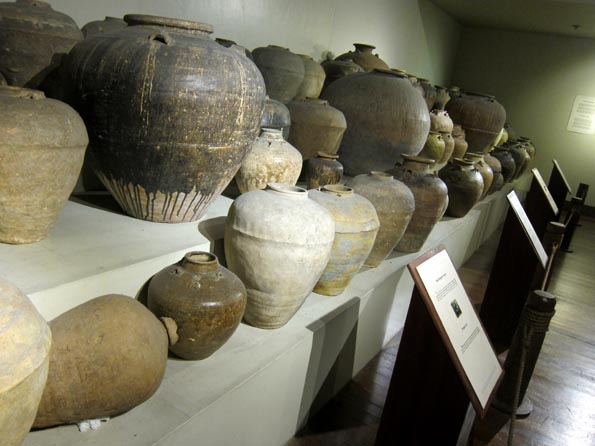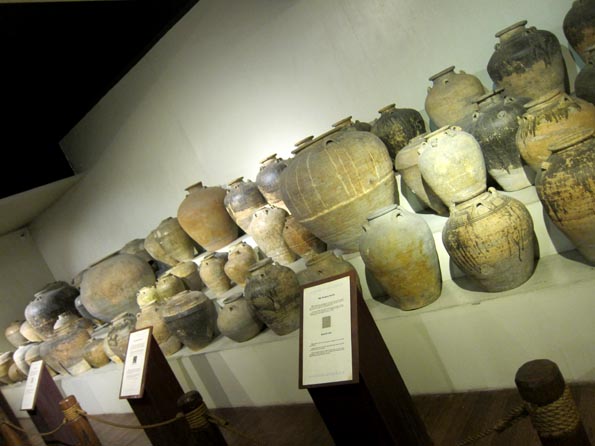一枚の特選フォト⌈海 & 船⌋
One Selected Photo "Oceans & Ships"
Back to: Top Page |
サンディエゴ号沈船 (その5)/引き揚げられたストーンウェア (石器)の壺類)
[フィリピン国立民族学博物館]


|
1600年12月のある日のこと、スペインのガレオン船サンディエゴ号はオランダの海賊船モーリシャス号とマニラ近海で戦闘となった。
そして、サンディエゴ号はマニラ湾外のフォーテュン島(Fortune Island)の沖1.4kmで、1600年12月14日午後3時頃に沈没の憂き目に合った。
マニラのフィリピン国立民族学博物館にはサンディエゴ号から引き揚げられた航海用具、道具類、武器や銃砲弾類の他に、数多くの 壺類(石器 stoneware)が展示されている。展示パネルには次のように記される。 サンディエゴ号の船艙には450名の人員のための食糧や水が積み込まれていた。壺類が船艙に配されていたが、それらは舶用の 容器であり、また船を安定させるバラストでもあった。沈船からおよそ800もの壺類が発見された。それらのほとんどは ビルマからのもので、16世紀に遡る代物である。 典型的な壺にあっては、その肩のところに取っ手があり、壺を安定させるためにロープが通されていた。いくつかの壺のアップリケ (象眼細工) は純粋に装飾的であった。船艙の壺は、傾けられた車輪のように船内の床の上を転がった。壺の肩には時々所有者の名前が 刻印されていた。
The hold of the San Diego contained food and water supplies for the 450-strong crew. Stoneware jars, doubling as containers and ballast for the ship, were placed in the hold. About 800 of the were found in the wreck. These jars came mostly from Burma and dated from the 16th century. The typical jar has applied handles on the shoulders, where a rope could be strung to secure it. On some jars, the appliques are purely decorative. The jars in the hold were rolled like slanted wheels on board along the floors. Their owner's name was sometimes carved on the jars' shoulder.
発見された石器の壺類のタイプについて、次のように記される。 サンディエゴ号の沈船の周辺には800個の壺類が散乱し、さらに沈船の骨組のところには1500個もの壺類が散らばっていた。それらの壺類の ほとんどは厚い脈石に覆われていた。 [詳細については下記英語版説明書き参照]
(I) Types of Stoneware Jars
One hundred twenty-four Siamese jars were found in the San Diego. These globular vessels can carry up to 300 liters of liquid. Vietnamese jars were also recovered. Their distinct charasteristic can be discerned from the seam that joins their upper and lower portions; separately fashioned, the parts were joined together afterwards. Martaban jars are named after the Burmese port city of Martaban. Distinguished for their dark brown/black or green glaze, "martabans" were used, mainly as storage for drinking water. The largest of the jars can hold up to 350 liters. There were about 70 Spanish jars recovered from the San Diego. These were used mainly for storing olives, wine, dried fruits and for transporting tar used for caulking. Shaped like inverted ovoids with a constricted neck and inverted rim, they were placed in the ship's hold and laid on straw. They can hold between two to fifteen liters and weigh from one to nine kilograms.
(II) Types of Stoneware Jars
Many similar examples are in museums in the Philippines, Malaysia and Indonesia, which demonstrates the extent to which these jars were used.
Globular or ovaloid with wide or narrow mouth, they were distributed throughout the East indies, the Persian Gulf and Turkey. Martabans were used as water or wine containers and as storage jars for trade goods and staples. On the San Diego, the largest Martaban jars contained drinking water.
Generally used to store olives and oil, these may have been reused to hold wine or even the tar used to caulk the ship. On board the galleon, they were stowed in rows and layers on a bed of straw. The capacity of the jars varied from 4.2 to 15.9 quarts (4 to 15 liters), and they weighed between 6.6 and 19.8 pounds (3 and 9 kg).
[参考資料] その他の展示パネルの説明書き
Another case contains a type of pottery called Tradescant jars, so called after the English botanist, John Tradescant (1627), who had such jars in his collection. These jars have five ears which were molded from greyish-yellow clay, decorated with foliage and flowers, either incised or in relief, and coated with a yellow and green feldspathic or lead glaze. The third case contains a set of earthware or wooden plugs used as stoppers for the narrow-necked bottles and jars. Only small amounts of their content were recovered, for the rags that used to seal the jars have long since dissolved in seawater. Several jars, however, still have their covers intact with their contents of food and curry.
The Archaeological Site
In addition to the 800 pieces of pottery scattered aroun the ship, another 1500 pieces of porcelain were scattered throughout the ships skelton. Most of the objects were covered with thick gangue, which was patiently removed. Some of the larger pieces required restoration. Treatment of the recovered porcelain and metal items was started in Manila and completed in France by various specialists and institutions.
[画像撮影: 2018.3.24 フィリピン・マニラ/国立民族学博物館にて] |
Back to: Top Page |